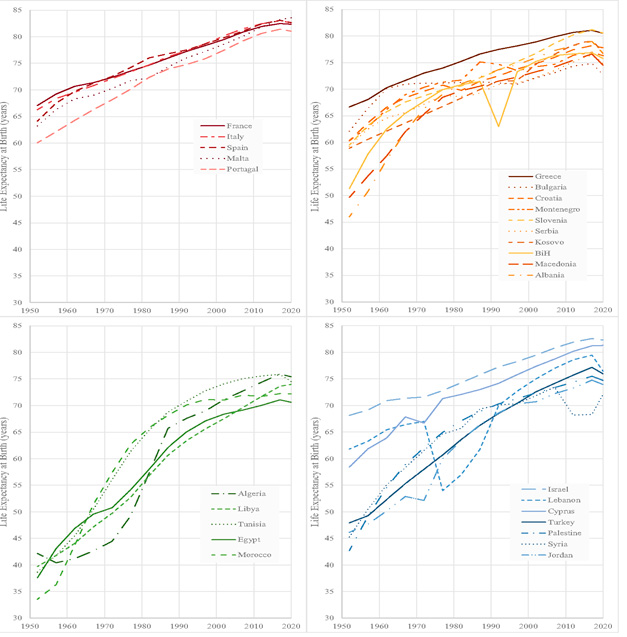|

|
Yoann Doignon,
Isabelle Blöss-Widmer,
Elena Ambrosett, Sébastien Oliveau
POPULATION DYNAMICS IN THE MEDITERRANEAN, A DEMOGRAPHIC
CONVERGENCE?
Springer, 2023, 161 pages
|
https://link.springer.com/book/10.1007/978-3-031-37759-4
|

Поло-возрастная пирамида Средиземноморья в 1950 и 2020 гг.
(стр. 36)

Возраст вступления в первый брак женщин в Средиземноморье
(1950-2019 гг.) (стр. 89)

Эволюция ожидаемой продолжительности жизни при
рождении в Средиземноморье (1950-2021 гг.) (стр. 101)

Распределение причин смерти от неинфекционных
заболеваний (стр. 112)

Вклад естественной и миграционной составляющих
в общий прирост численности населения стран Средиземноморья
в разные периоды (1950-1955, 1990-1995, 2015-2020) (стр. 136)
|
В публикации проводится сравнительный обзор демографической
эволюции населения Средиземноморья. В ней рассматриваются все демографические
процессы с 1950 года, такие как рождаемость, смертность, рост численности
населения, демографическое старение и возрастная структура населения.
В книге обсуждаются основные демографические изменения и их последствия
для Средиземноморского региона, а также описываются социально-экономические
и социальные возможности, такие как серебряная экономика, улучшение
здоровья населения и прогресс в образовании. В работе рассматривается
26 стран.
Contents
1. General Introduction: A Study of Mediterranean Populations
1.1. A Book Addressing the Lack of Pan-Mediterranean Demographic
Studies
1.1.1. In Search of Human Unity in the Mediterranean
1.1.2. The Mediterranean and Population Sciences
1.1.3. A Lack of Pan-Mediterranean Demographic Studies
1.2. Approach and Commitment
1.2.1. What Do We Mean by the Mediterranean?
1.2.2. International Comparisons Over Time
1.2.3. Grid Convergence to Analyse Demographic Phenomena
1.2.4. Data Used
1.3. Structure of the Book
References
2. Spatial Distribution of Population and Urbanisation
2.1. Introduction
2.2. Uneven Distribution of the Population
2.3. Far from Determinism: Opportunities and Constraints of Mediterranean
Areas
2.4. A Very Coastal and Increasing Urbanisation
2.5. Settlement Challenges in the Mediterranean
References
3. Sex Ratio, Age Structure and Population Ageing
3.1. Introduction
3.2. Gender Inequalities in the Mediterranean
3.3. An Ageing Population
3.4. Ongoing Significant Differences in Age Structure Between
Regions
3.5. Implications and Consequences of Age Structure Differences
References
4. The Various of Demographic Transitions
4.1. Introduction
4.2. Demographic Transition "Models"
4.2.1. Type 1: Ancient Transition with Pseudo-Equilibrium in the
1970s (Spain, France)
4.2.2. Type 2: Transition with Pseudo-Equilibrium in the Late
1990s (Cyprus, Montenegro, Malta)
4.2.3. Type 3: Rapid Transition with Late Pseudo-Equilibrium from
the 2000s Onwards (Macedonia, Albania, Kosovo)
4.3. Completed Demographic Transition with a Post-Transitional
Decline Regime
4.3.1. Type 4: Transition with Pseudo-Equilibrium in the 1980s-1990s
(Italy, Portugal, Greece, Slovenia, Croatia, Bulgaria)
4.3.2. Type 5: Transition with Pseudo-Equilibrium in the 2000s
(Serbia, Bosnia-Herzegovina)
4.4. Completed Demographic Transition with a Post-Transitional
Regime with Sustained Population Growth (Type 6: Israel)
4.5. Recent and Rapid Demographic Transition, Now Being Finalised
4.5.1. Type 7: Transition Already Underway in 1950 (Lebanon, Turkey)
4.5.2. Type 8: More Recent Transition (Libya, Morocco, Tunisia)
4.6. Possible Demographic Counter-Transitions (Type 9: Egypt,
Algeria)
4.7. Recent and Ongoing Transition, Slower Decline in Birth Rate
(Type 10: Jordan, Palestine, Syria)
4.8. A Diversity of Demographic Transitions Despite a General
Convergence
References
5. Fertility Intensity and Timing
5.1. Introduction
5.2. A Global Fertility Convergence
5.3. The Intersection of Birth Timing and Fertility Intensity
5.3.1. Mean Age at Childbearing
5.3.2. Fertility by Age Group
5.4. Specific Contributions of Age Groups
5.5. (Un)certainties for the Future of Mediterranean Fertility
References
6. Family Formation and Dissolution
6.1. Introduction
6.2. Major Marriage and Divorce Trends
6.2.1. Marriage
6.2.2. Divorce
6.3. Changes in Marriage
6.3.1. An Increase in Age at Marriage
6.3.2. Permanent Celibacy
6.3.3. Summary of Family Models
6.4. Conclusion
References
7. Mortality Profiles
7.1. Introduction
7.2. Mortality at All Ages: Life Expectancy at Birth
7.2.1. A Very Heterogeneous Picture in 1950
7.2.2. General Convergence Since 1950
7.2.3. Decreases in Life Expectancy at Birth
7.2.4. Gender Inequalities
7.3. The Different Mortality Profiles
7.3.1. Infant and Child Mortality (Under 5 Years Old)
7.3.2. Adult Mortality (15-64 Years Old)
7.3.3. Mortality at Advanced Ages (65 Years Old or Older)
7.4. The Health Transition
7.5. Conclusion
References
8. The Mediterranean Migration System
8.1. Introduction
8.2. Migration in the Mediterranean (1950-1995)
8.3. Migration in the Mediterranean in the XXI Century
8.4. Two Emerging Phenomena: High Skilled and Irregular Migration
8.5. Conclusions
References
9. Population Dynamics and Their Components
9.1. Introduction
9.2. Evolving Power Relations
9.3. Natural and Migration Dynamics: Which Combinations Exist
in the Mediterranean?
9.3.1. Natural Dynamics: South and East
9.3.2. Migration Dynamics: Sending Versus Receiving Countries
9.4. Growth Outlook to 2060: What Can We Expect?
References
10. ConclusionsAn Overview of Population Dynamics in
the Mediterranean
10.1. Major Demographic Developments Since 1950
10.2. An Assessment of the Book's Overall Approach
References
References
|

